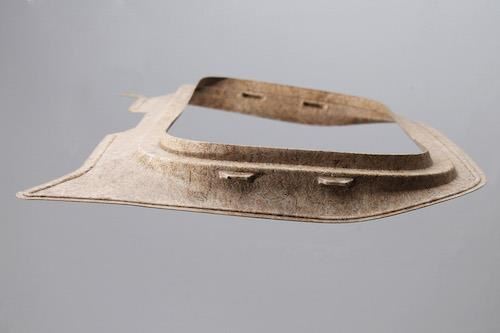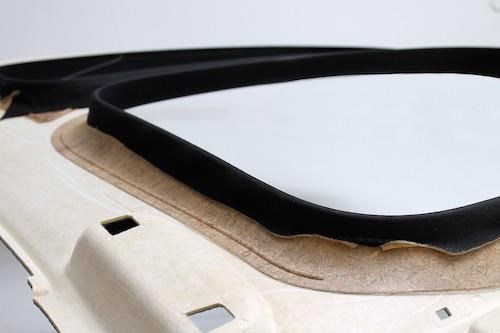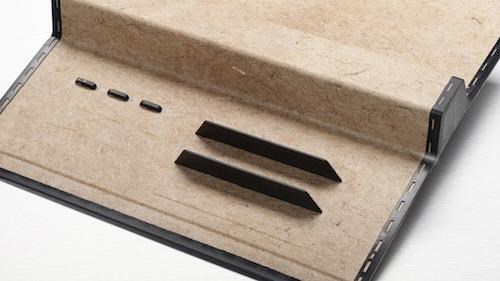Natural fiber composites gaining traction in automotive
New water-borne, wet-application acrylic resin enables new opportunities in car interiors.
As reported in the CompositesWorld March 2016 article, “Natural fiber composites: Market share, one part at a time” (see Learn More located under Editor's Picks on the top right), the natural fibers industry continues to develop. And the automotive industry has helped lead the way with its adoption of natural fibers for door panels, seat backs and trunk liners. Now the industry can add a roof frame to that list.
Working with BASF Corporation (Ludwigshafen, Germany), Germany-based International Automotive Components (IAC) has launched its FiberFrame natural fiber sun roof frame on the 2017 Mercedes-Benz E-Class, which is reportedly the first automotive roof frame entirely made of nonwoven natural fiber composites. The proprietary innovation is made of 70% renewable raw material content in the form of natural fiber and, therefore, is said to provide up to 50% weight savings, compared to conventional metal-reinforced sun roof frames.
The FiberFrame’s reinforcement (Fig. 1) is IAC’s EcoMatHot natural fiber-based prepreg, which was specifically devel- oped for this application. The fiber mat is impregnated with an acrylate-based resin matrix, called Acrodur 950 L, provided by BASF. Acrodur is a water-based, formaldehyde-free, one-component system. But its underlying technology is based on the thermal crosslinking of polycarboxylic acids with a multi-functional alcohol. Unlike classical two-component reactive resins, however, no organic substances, such as asphenol or formaldehyde, are released during the crosslinking process. Theonly by-product of cure is water. It is, therefore, an extremely low- to no-volatile organic compound (VOC) solution, which makes it a compatible companion for natural fibers. But Henning Karbstein, manager for new business development and idea management at BASF’s dispersions and pigments business in Charlotte, NC, US, says its appeal extends much further. Acrodur 950 L’s formulation also combines the benefits of reactive acrylate resins with those of conventional thermoplastic acrylate dispersions. What happens during processing is that it begins as a thermoplastic and then, during the polycarboxylic acid phase under heat, it crosslinks to a thermoset polymer.
“When you have impregnated the fiber by crosslinking, it becomes a resolute bond between the Acrodur molecule and the fiber and thermoset,” he says.
The IAC project’s steps begin with wet-impregnating the dry natural fiber mat, in this case, bast fiber, which is done by an outside prepregger. Because Acrodur is water-based, impregnation is thorough. Wet impregnation also allows for easy application of additives, such as colorants or flame retardants. The fiber mats are dried after impregnation with a conventional convection oven or with radio frequency drying techniques. IAC then receives the prepregged fiber mat, which is still soft and flexible. The frame is then manufactured in-house by IAC in a hot molding process.
“In the specification of the IAC EcoMatHot fiber mat, as well as in terms of tooling technology and production process of this innovation, we were able to take advantage of more than 20 years of experience working with natural fiber-reinforced materials in automotive interiors,” says IAC director of advanced engineering Fritz Schweindl. “By manufacturing this product in-house in our headliner plant, we follow our strategy and expansion of vertical integration of our interior systems. Thanks to our global manu- facturing footprint and standardized processes, we are now able to adapt IAC FiberFrame to customer needs and supply it around the world.”
Schweindl says it was relatively easy to integrate the Acrodur prepreg into IAC’s production system. “The natural fiber components that are strengthened with Acrodur are ideal to mold; they are environmentally friendly and save time during the production of the composites,” he comments, adding, “Furthermore, the product is low in emissions, which means that it is safer to work with.”
FiberFrame started production in November 2015 at IAC’s Center of Excellence for overhead products in Prestice, Czech Republic, to support the Mercedes-Benz E-Class launch. The company also produces the headliner, the outer-rear wheel house liner, inner wheel house cover and rear seat cover for the vehicle.
BASF resin helps boost natural fibers
BASF says Acrodur turns natural fibers into functional and environmentally friendly materials. The company believes it’s well-suited for molded parts made from natural fiber and post-moldable nonwovens.
“Both our Acrodur families (thermoset and thermoplastic) have been developed for best bonding characteristics on these fiber types, while polypropylene acts more as a melted ‘glue’ in the voids between fibers,” Karbstein says.
Unlike other high-strength natural fiber-compatible resins, such as urea formaldehyde (UF), phenol formaldehyde (PF) or MDI resins, which are common for wood and cellulose fiber bonding, Acrodur does not emit harmful VOCs during production, handling or use. Because the only curing byproduct is water, Karbstein says these resins are suitable for safe applications in the automotive interiors and home/office furnishings industries.
In the automotive market, short wood fibers, long kenaf/ jute/hemp (bast type) fibers and glass fibers have been infused with polypropylene (PP) for a long time. Use of nonwoven fiber composites, mostly natural fiber/PP and glass/PP, has been on the rise because they perform better than simple injection molded plastics. Although PP also poses a less-critical VOC risk than formaldehyde-based resins or MDI, Karbstein says that Acrodur outdoes PP by reducing chemical use by increasing the fiber content.
Although sustainability is important in the automotive business, even more essential is cost vs. weight and performance for the material choices of OEMs and Tier 1s. Acrodur-based nonwoven composites (mostly with natural bast fibers) allow for an increase of about 20% in mechanical performance. Further, Acrodur resin content in the finished part can be as low as 25-28%, while the same part made with a PP-impregnated nonwoven is usually a 50/50 mix. Karbstein says this more efficient resin usage, attributed to the chemistry and the processing method, is also the key to weight savings. “The 20% increase in performance is the bottom line lightweighting benefit for automotive applications,” he says. “BASF sees a high demand for this benefit currently in the automotive market.”
Expanding applications
Although BASF has a longer list of products in the Acrodur family, Karbstein says those most important for automotive applications are its thermoset (duroplastic) Acrodur 950L solution, and a latex-modified version called Acrodur DS3515 dispersion. Compared to 950L, DS3515 offers more ductility for impact-critical applications.
On the thermoplastic side, Acrodur Power 2750 is BASF’s direct replacement for PP
as a drop-in solution (Fig. 3). It is applied wet, as are the thermoset options, but beside that, processing is practically the same as for unfilled PP or glass/PP.
“We are working on a number of projects with the automotive industry right now for interior applications, like door panels, headliners or roof components, trunk liners or other nonstructural interior panels,” Karbstein says, but adds that broader applications are likely in the future. “We believe, based on test results, that we are also able to introduce natural fiber nonwoven composites with Acrodur to exterior applications, such as underbody aeroshielding or wheel wells,” he contends, adding, “When applied with flame retardants, Acrodur nonwoven composites can also be used for fire-critical areas, like underhood applications.”
Related Content
The potential for thermoplastic composite nacelles
Collins Aerospace draws on global team, decades of experience to demonstrate large, curved AFP and welded structures for the next generation of aircraft.
Read MoreTU Munich develops cuboidal conformable tanks using carbon fiber composites for increased hydrogen storage
Flat tank enabling standard platform for BEV and FCEV uses thermoplastic and thermoset composites, overwrapped skeleton design in pursuit of 25% more H2 storage.
Read MorePlant tour: Albany Engineered Composites, Rochester, N.H., U.S.
Efficient, high-quality, well-controlled composites manufacturing at volume is the mantra for this 3D weaving specialist.
Read MoreRecycling end-of-life composite parts: New methods, markets
From infrastructure solutions to consumer products, Polish recycler Anmet and Netherlands-based researchers are developing new methods for repurposing wind turbine blades and other composite parts.
Read MoreRead Next
Natural fiber composites: Market share, one part at a time
Suppliers and adventurous composites fabricators put the “feel good” aspect in the rearview mirror, winning customers by competing on price and performance.
Read MoreModeling and characterization of crushable composite structures
How the predictive tool “CZone” is applied to simulate the axial crushing response of composites, providing valuable insights into their use for motorsport applications.
Read MoreVIDEO: High-rate composites production for aerospace
Westlake Epoxy’s process on display at CAMX 2024 reduces cycle time from hours to just 15 minutes.
Read More













.jpg;maxWidth=300;quality=90)













